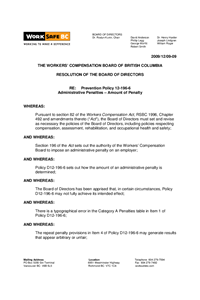BOD Decision -2009/12/09-09 – Prevention Policy 12-196-6 Administrative Penalties – Amount of Penalty
At their December 9, 2009 meeting, the Board of Directors approved amendments to Policy D12-196-6 Administrative Penalties – Amount of Penalty.
A vice-chair of the Workers’ Compensation Appeal Tribunal (“WCAT”) recommended that “the policy concerning repeat penalties be reviewed to ensure that the wording of the policy reflects the intent of the policy-makers.”
A repeat penalty is calculated at a higher level than a regular penalty and is imposed when a prior penalty has been imposed for the same or similar violation within the preceding three-year period. A higher repeat penalty provides additional motivation for an employer who was not motivated to comply by the regular penalty amount.
Policy D12-196-6 of the Prevention Manual sets out when a repeat penalty is imposed and how it is calculated. The vice-chair at WCAT said this policy allows for some arbitrariness as it allows a repeat penalty to be imposed in circumstances where the employer would not have had an opportunity to modify its behaviour prior to receiving the increased penalty.
Based on the facts of the case, the vice-chair at WCAT upheld the repeat penalty that had been imposed. The comments made by the vice-chair have not resulted in a referral under section 251 of the Workers Compensation Act. However, with a slight change in the facts, a similar case could result in a formal referral. It was determined that it was prudent to amend the policy at this time to address the concerns raised by the vice-chair.
The existing repeat penalty policy is based on a three-year time frame. The triggering event for starting that time frame is the date the first penalty is imposed. Most of the arbitrary results that can occur under the policy flow from the differing amount of time it can take to impose an administrative penalty due to factors such as complexity, the involvement of other agencies, administrative delay, and time provided to an employer to respond to a proposed penalty. This can mean that a penalty is not imposed until many months after the violation. This can give rise to results that appear arbitrary, such as:
- If two violations occur days or weeks apart, but the penalty for the second violation is imposed first, the penalty for the first violation will then become a repeat penalty;
- If two violations occur on the same day, but the penalties are not imposed on the same day, the later penalty will be a repeat penalty;
- If two violations occur within three years of one another, but the penalty for the second violation is imposed more than three years after the penalty is imposed for the first violation, it will not be a repeat penalty;
- If two violations occur more than three years apart, but the penalty for the second violation is imposed less than three years after the penalty is imposed for the first violation, it will be a repeat penalty.
It was determined that these arbitrary results will be significantly reduced and the policy will better achieve its objective if repeat penalties are based on the dates of the violations giving rise to the penalties, rather than on the dates the penalties are imposed. Thus, the policy has been amended to provide that a repeat penalty will be imposed for similar violations that occurred within three years of one another and resulted in a prior penalty, provided the employer was provided at least 14 days notice that a penalty had been imposed or was being considered for the earlier violation.
A second issue in the same policy, not raised by the WCAT case but identified by staff, is a typographical error in the table used to calculate Category A Penalties. This could result in some unfairness between employers in calculating the amount of a penalty. The policy has been amended to correct this error and eliminate this potential unfairness. The starting point for calculating a penalty with a payroll above $5 million dollars has been changed to $68,750 from $68,250.
These amendments became effective on January 2, 2010.

